clutch Hyundai Ioniq Hybrid 2018 Owner's Guide
[x] Cancel search | Manufacturer: HYUNDAI, Model Year: 2018, Model line: Ioniq Hybrid, Model: Hyundai Ioniq Hybrid 2018Pages: 642, PDF Size: 16.33 MB
Page 515 of 642

7-8
Maintenance
SCHEDULED MAINTENANCE SERVICES
At least once a year:
• Clean body and door drain holes.
• Lubricate door hinges and hood
hinges.
• Lubricate door and hood locks and
latches.
• Lubricate door rubber weather
strips.
• Check the air conditioning system.
• Inspect and lubricate dual clutch
transmission linkage and controls.
• Clean the battery and terminals.
• Check the brake fluid level.Follow Normal Maintenance Schedule if the vehicle is usually operated where
none of the following conditions apply. If any of the following conditions apply,
you must follow the Maintenance Under Severe Usage Conditions.
• Repeated driving short distance of less than 8 km (5 miles) in normal tem-
perature or less than 16 km (10miles) in freezing temperature
• Extensive engine idling or low speed driving for long distances
• Driving on rough, dusty, muddy, unpaved, graveled or salt-spread roads
• Driving in areas using salt or other corrosive materials or in very cold
weather
• Driving in heavy dust condition
• Driving in heavy traffic area
• Driving on uphill, downhill, or mountain road repeatedly
• Towing a trailer or using a camper, or roof rack
• Driving as a patrol car, taxi, other commercial use of vehicle towing
• Driving over 170 km/h (106 miles/h)
• Frequently driving in stop-and-go condition
If your vehicle is operated under the above conditions, you should inspect,
replace or refill more frequently than the following Normal Maintenance
Schedule. After the periods or distance shown in the chart, continue to follow
the prescribed maintenance intervals.
Page 518 of 642

7-11
7
Maintenance
Normal maintenance schedule - For Europe (except Russia)
I : Inspect and if necessary, adjust, correct, clean or replace.
R : Replace or change.
*
6: When adding coolant, use only deionized water or soft water for your vehicle and never mix hard water in the coolant filled at
the factory.
An improper coolant mixture can result in serious malfunction or engine damage.
*
7: For your convenience, it can be replaced prior to it's interval when you do maintenance of other items.
*8: Dual clutch transmission (DCT) fluid should be changed anytime it has been submerged in water.
Number of months or driving distance, whichever comes first
Months1224364860728496
Miles×1,0001020304050607080
Km×1,000153045607590105120
Cooling system
Inspect “Coolant level adjustment and leak” every day
At first, inspect 60,000 km (40,000 miles) or 48 months
after that, inspect every 30,000 km (20,000 miles) or 24 months
Engine coolant / Inverter coolant *6 At first, replace 210,000 km (140,000 miles) or 120 months
after that, replace every 30,000 km (20,000 miles) or 24 months*7
Dual clutch transmission fluid *8II
Engine clutch actuator fluidIRIRIRIR
Engine clutch actuator hose and lineIIIIIIII
Battery condition (12V, Plug-in hybrid vehicle)IIIIIIII
Brake lines, hoses and connectionsIIIIIIII
Brake pedalIIII
Parking brakeIIII
Brake fluidIRIRIRIR
Brake discs and padsIIIIIIII
MAINTENANCE
INTERVALS
MAINTENANCE
ITEM
Page 520 of 642
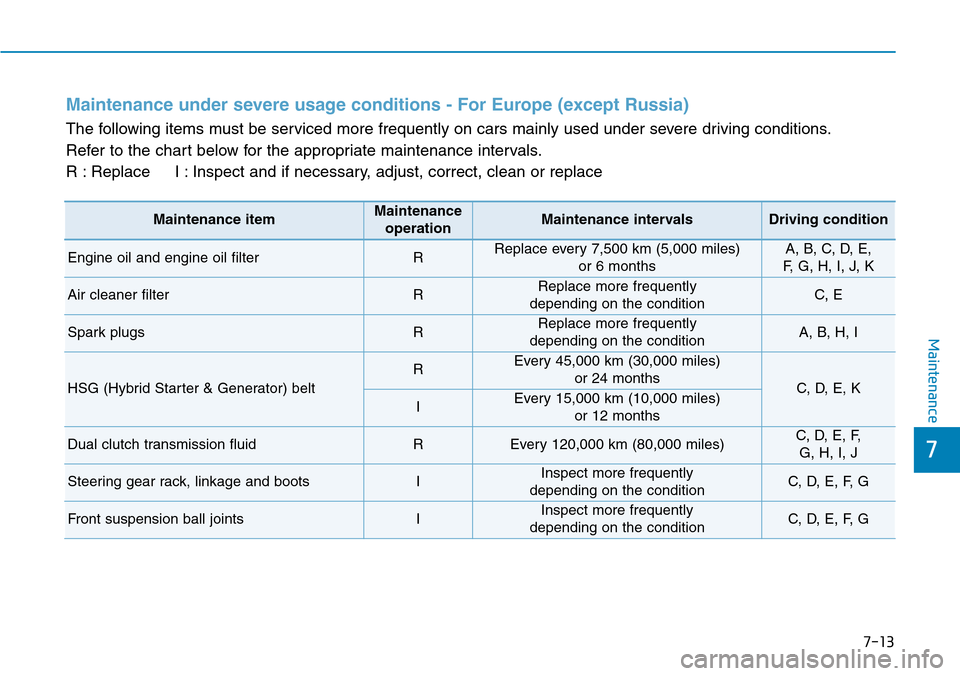
7-13
7
Maintenance
Maintenance under severe usage conditions - For Europe (except Russia)
The following items must be serviced more frequently on cars mainly used under severe driving conditions.
Refer to the chart below for the appropriate maintenance intervals.
R : Replace I : Inspect and if necessary, adjust, correct, clean or replace
Maintenance itemMaintenance
operationMaintenance intervalsDriving condition
Engine oil and engine oil filterRReplace every 7,500 km (5,000 miles)
or 6 monthsA, B, C, D, E,
F, G, H, I, J, K
Air cleaner filterRReplace more frequently
depending on the conditionC, E
Spark plugs RReplace more frequently
depending on the conditionA, B, H, I
HSG (Hybrid Starter & Generator) belt
REvery 45,000 km (30,000 miles)
or 24 months
C, D, E, K
IEvery 15,000 km (10,000 miles)
or 12 months
Dual clutch transmission fluidREvery 120,000 km (80,000 miles)C, D, E, F,
G, H, I, J
Steering gear rack, linkage and bootsIInspect more frequently
depending on the conditionC, D, E, F, G
Front suspension ball jointsIInspect more frequently
depending on the conditionC, D, E, F, G
Page 524 of 642
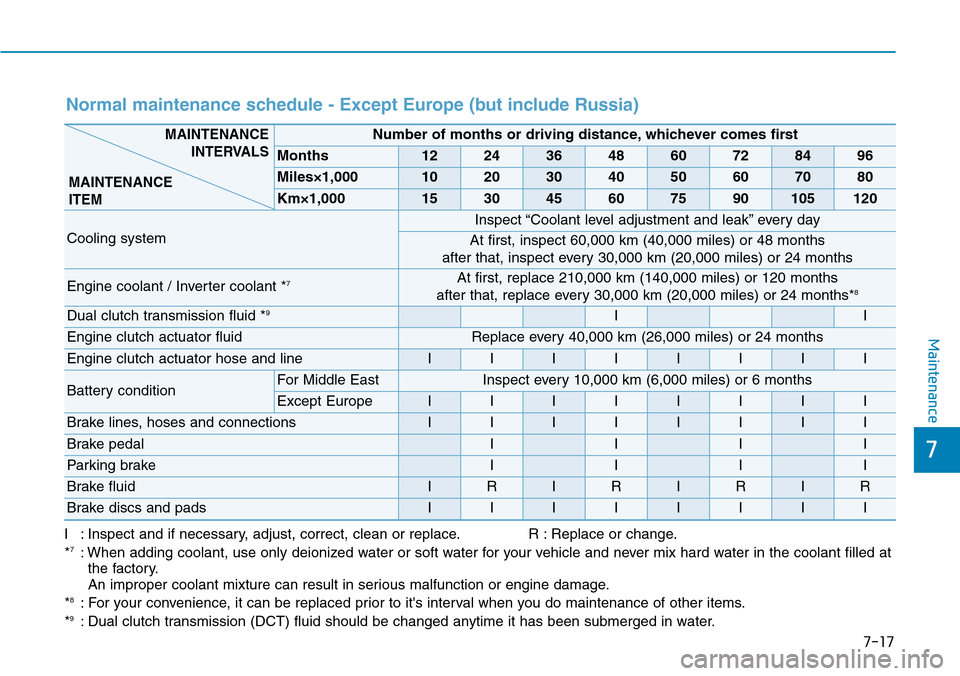
7-17
7
Maintenance
Normal maintenance schedule - Except Europe (but include Russia)
Number of months or driving distance, whichever comes first
Months1224364860728496
Miles×1,0001020304050607080
Km×1,000153045607590105120
Cooling system
Inspect “Coolant level adjustment and leak” every day
At first, inspect 60,000 km (40,000 miles) or 48 months
after that, inspect every 30,000 km (20,000 miles) or 24 months
Engine coolant / Inverter coolant *7At first, replace 210,000 km (140,000 miles) or 120 months
after that, replace every 30,000 km (20,000 miles) or 24 months*8
Dual clutch transmission fluid *9II
Engine clutch actuator fluidReplace every 40,000 km (26,000 miles) or 24 months
Engine clutch actuator hose and lineIIIIIIII
Battery conditionFor Middle EastInspect every 10,000 km (6,000 miles) or 6 months
Except EuropeIIIIIIII
Brake lines, hoses and connectionsIIIIIIII
Brake pedalIIII
Parking brakeIIII
Brake fluidIRIRIRIR
Brake discs and padsIIIIIIII
MAINTENANCE
INTERVALS
MAINTENANCE
ITEM
I : Inspect and if necessary, adjust, correct, clean or replace. R : Replace or change.
*7: When adding coolant, use only deionized water or soft water for your vehicle and never mix hard water in the coolant filled at
the factory.
An improper coolant mixture can result in serious malfunction or engine damage.
*
8: For your convenience, it can be replaced prior to it's interval when you do maintenance of other items.
*9: Dual clutch transmission (DCT) fluid should be changed anytime it has been submerged in water.
Page 526 of 642
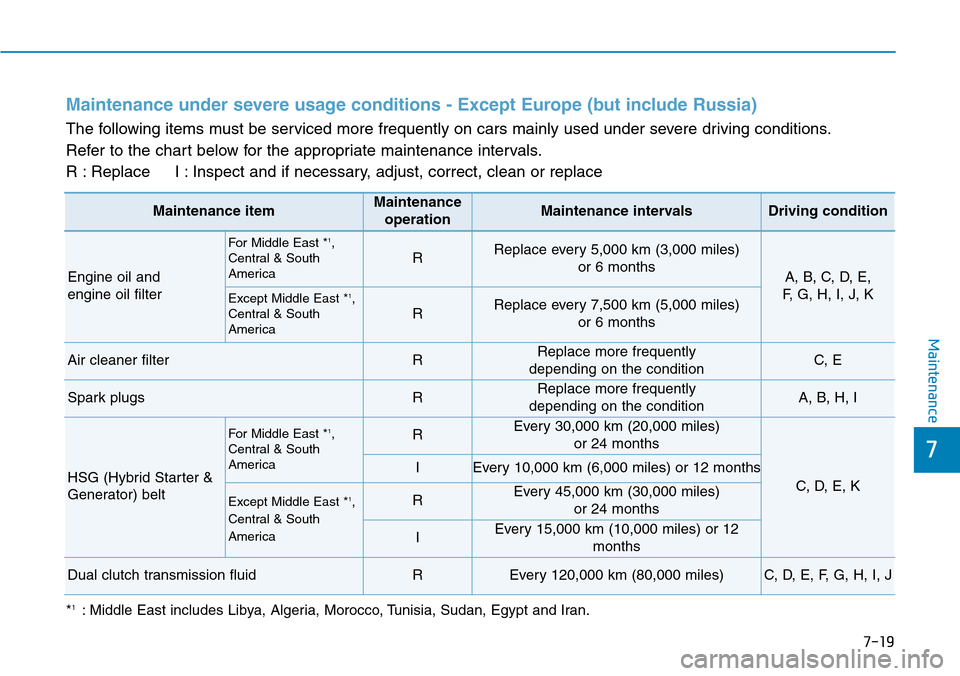
7-19
7
Maintenance
Maintenance under severe usage conditions - Except Europe (but include Russia)
The following items must be serviced more frequently on cars mainly used under severe driving conditions.
Refer to the chart below for the appropriate maintenance intervals.
R : Replace I : Inspect and if necessary, adjust, correct, clean or replace
Maintenance itemMaintenance
operationMaintenance intervalsDriving condition
Engine oil and
engine oil filter
For Middle East *1,
Central & South
AmericaRReplace every 5,000 km (3,000 miles)
or 6 months
A, B, C, D, E,
F, G, H, I, J, K
Except Middle East *1,
Central & South
AmericaRReplace every 7,500 km (5,000 miles)
or 6 months
Air cleaner filterRReplace more frequently
depending on the conditionC, E
Spark plugs RReplace more frequently
depending on the conditionA, B, H, I
HSG (Hybrid Starter &
Generator) belt
For Middle East *1,
Central & South
AmericaREvery 30,000 km (20,000 miles)
or 24 months
C, D, E, K
IEvery 10,000 km (6,000 miles) or 12 months
Except Middle East *1,
Central & South
AmericaREvery 45,000 km (30,000 miles)
or 24 months
IEvery 15,000 km (10,000 miles) or 12
months
Dual clutch transmission fluidREvery 120,000 km (80,000 miles)C, D, E, F, G, H, I, J
*1: Middle East includes Libya, Algeria, Morocco, Tunisia, Sudan, Egypt and Iran.
Page 529 of 642

7-22
Maintenance
Dual clutch transmission fluid
The dual clutch transmission fluid
should be inspected according to the
intervals specified in the mainte-
nance schedule.
Engine clutch actuator fluid
The engine clutch actuator fluid level
should be inspected or replaced to
the intervals specified in the mainte-
nance schedule.
Brake hoses and lines
Visually check for proper installation,
chafing, cracks, deterioration and
any leakage. Replace any deteriorat-
ed or damaged parts immediately.
Brake fluid
Check the brake fluid level in the
brake fluid reservoir. The level should
be between the MIN and the MAX
marks on the side of the reservoir.
Use only hydraulic brake fluid con-
forming to DOT 3 or DOT 4 specifi-
cation.
Parking brake
Inspect the parking brake system
including the parking brake pedal
and cables.
Brake discs, pads, calipers
and rotors
Check the pads, the disc, and the
rotor for any excessive wear-out.
Inspect calipers for any fluid leakage
For more information on checking
the pads or lining wear limit, refer to
the HYUNDAI web site.
(http://ser
vice.hyundai-motor.com)
Exhaust pipe and muffler
Visually inspect the exhaust pipes,
muffler and hangers for cracks, dete-
rioration, or damage. Start the
engine and listen carefully for any
exhaust gas leakage. Tighten con-
nections or replace parts as neces-
sary.
Suspension mounting bolts
Check the suspension connections
for looseness or damage. Retighten
to the specified torque.
Steering gear box, linkage &
boots/lower arm ball joint
With the vehicle stopped and the
hybrid system off, check for exces-
sive free-play in the steering wheel.
Check the linkage for bends or dam-
age. Check the dust boots and ball
joints for deterioration, cracks, or
damage.
Replace any damaged parts.
Drive shafts and boots
Check the drive shafts, boots and
clamps for cracks, deterioration, or
damage. Replace any damaged
parts and, if necessary, repack the
grease.
Air conditioning refrigerant
Check the air conditioning lines and
connections for leakage and damage.
Page 571 of 642
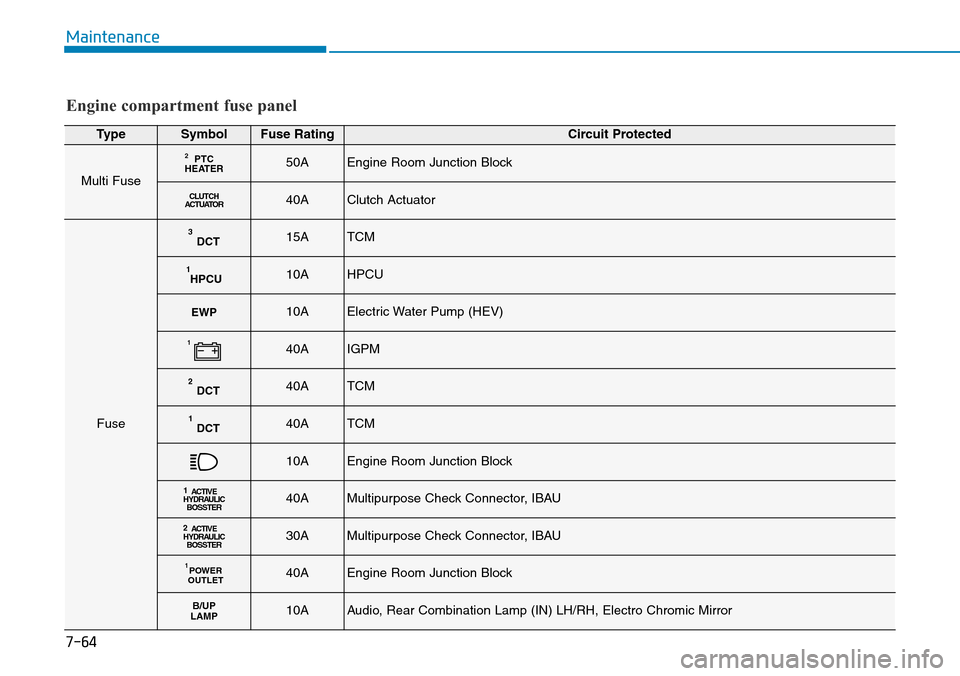
7-64
Maintenance
TypeSymbolFuse RatingCircuit Protected
Multi Fuse
PTC
HEATER250AEngine Room Junction Block
CLUTCH
ACTUATOR40AClutch Actuator
Fuse
DCT315ATCM
HPCU110AHPCU
EWP10AElectric Water Pump (HEV)
140AIGPM
DCT240ATCM
DCT140ATCM
10AEngine Room Junction Block
1
ACTIVE
HYDRAULIC
BOSSTER40AMultipurpose Check Connector, IBAU
2
ACTIVE
HYDRAULIC
BOSSTER30AMultipurpose Check Connector, IBAU
POWER
OUTLET140AEngine Room Junction Block
B/UP
LAMP10AAudio, Rear Combination Lamp (IN) LH/RH, Electro Chromic Mirror
Engine compartment fuse panel
Page 572 of 642

7-65
7
Maintenance
TypeSymbolFuse RatingCircuit Protected
Fuse
POWER
OUTLET320ACigarette Lighter
POWER
OUTLET220APower Outlet
215AIGPM, Rear Defogger (+) (Lower)
S210AEngine Room Junction Block, Purge Control Solenoid Valve, Mass Air Flow Sensor
E120AECM
S115AOxygen Sensor (Up), Oxygen Sensor (Down)
IGN
COIL20AIgnition Coil #1~#4
E215AECM
10ABurglar Alarm Horn Relay
E310AECM
HPCU215AHPCU, Clutch Actuator (HEV)
3
ACTIVE
HYDRAULIC
BOSSTER10AMultipurpose Check Connector, IBAU
DCT415ADCT Shift Lever, TCM, Transaxle Range Switch
Engine compartment fuse panel
Page 608 of 642
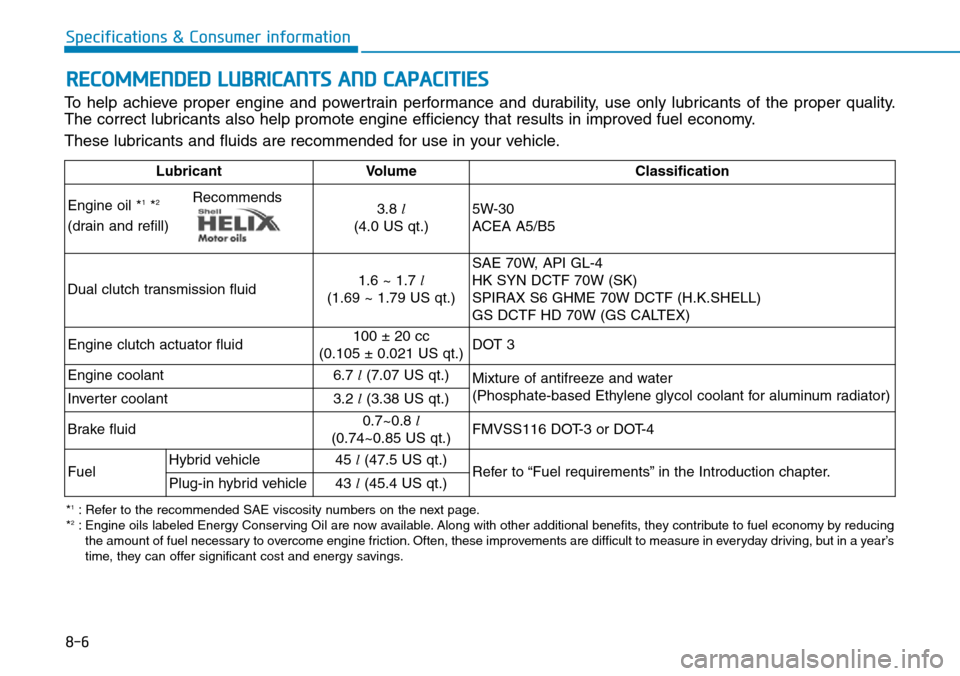
8-6
Specifications & Consumer information
RECOMMENDED LUBRICANTS AND CAPACITIES
To help achieve proper engine and powertrain performance and durability, use only lubricants of the proper quality.
The correct lubricants also help promote engine efficiency that results in improved fuel economy.
These lubricants and fluids are recommended for use in your vehicle.
Lubricant Volume Classification
Engine oil *
1*2Recommends
(drain and refill)3.8 l
(4.0 US qt.)5W-30
ACEA A5/B5
Dual clutch transmission fluid1.6 ~ 1.7 l
(1.69 ~ 1.79 US qt.)SAE 70W, API GL-4
HK SYN DCTF 70W (SK)
SPIRAX S6 GHME 70W DCTF (H.K.SHELL)
GS DCTF HD 70W (GS CALTEX)
Engine clutch actuator fluid100 ± 20 cc
(0.105 ± 0.021 US qt.)DOT 3
Engine coolant6.7 l(7.07 US qt.)
Mixture of antifreeze and water
(Phosphate-based Ethylene glycol coolant for aluminum radiator)
Inverter coolant3.2 l(3.38 US qt.)
Brake fluid0.7~0.8 l
(0.74~0.85 US qt.)FMVSS116 DOT-3 or DOT-4
FuelHybrid vehicle45 l(47.5 US qt.)
Refer to “Fuel requirements” in the Introduction chapter.
Plug-in hybrid vehicle43 l(45.4 US qt.)
*1: Refer to the recommended SAE viscosity numbers on the next page.
*2: Engine oils labeled Energy Conserving Oil are now available. Along with other additional benefits, they contribute to fuel economy by reducing
the amount of fuel necessary to overcome engine friction. Often, these improvements are difficult to measure in everyday driving, but in a year’s
time, they can offer significant cost and energy savings.
Page 634 of 642
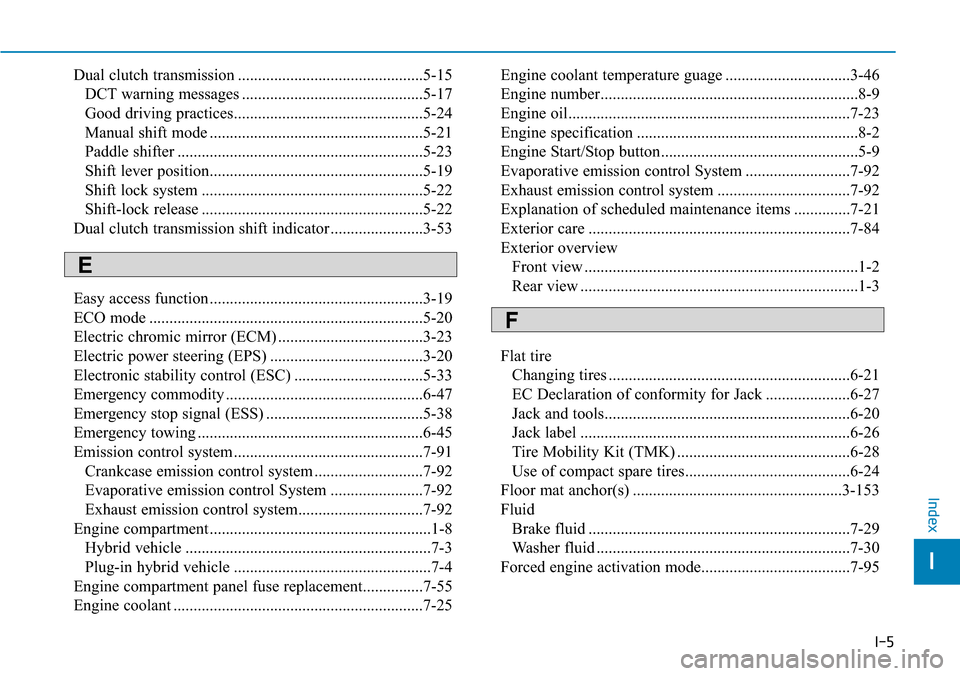
I-5
Dual clutch transmission ..............................................5-15
DCT warning messages .............................................5-17
Good driving practices...............................................5-24
Manual shift mode .....................................................5-21
Paddle shifter .............................................................5-23
Shift lever position.....................................................5-19
Shift lock system .......................................................5-22
Shift-lock release .......................................................5-22
Dual clutch transmission shift indicator .......................3-53
Easy access function .....................................................3-19
ECO mode ....................................................................5-20
Electric chromic mirror (ECM) ....................................3-23
Electric power steering (EPS) ......................................3-20
Electronic stability control (ESC) ................................5-33
Emergency commodity .................................................6-47
Emergency stop signal (ESS) .......................................5-38
Emergency towing ........................................................6-45
Emission control system ...............................................7-91
Crankcase emission control system ...........................7-92
Evaporative emission control System .......................7-92
Exhaust emission control system...............................7-92
Engine compartment .......................................................1-8
Hybrid vehicle .............................................................7-3
Plug-in hybrid vehicle .................................................7-4
Engine compartment panel fuse replacement...............7-55
Engine coolant ..............................................................7-25Engine coolant temperature guage ...............................3-46
Engine number................................................................8-9
Engine oil......................................................................7-23
Engine specification .......................................................8-2
Engine Start/Stop button.................................................5-9
Evaporative emission control System ..........................7-92
Exhaust emission control system .................................7-92
Explanation of scheduled maintenance items ..............7-21
Exterior care .................................................................7-84
Exterior overview
Front view ....................................................................1-2
Rear view .....................................................................1-3
Flat tire
Changing tires ............................................................6-21
EC Declaration of conformity for Jack .....................6-27
Jack and tools.............................................................6-20
Jack label ...................................................................6-26
Tire Mobility Kit (TMK) ...........................................6-28
Use of compact spare tires.........................................6-24
Floor mat anchor(s) ....................................................3-153
Fluid
Brake fluid .................................................................7-29
Washer fluid ...............................................................7-30
Forced engine activation mode.....................................7-95
I
Index
E
F